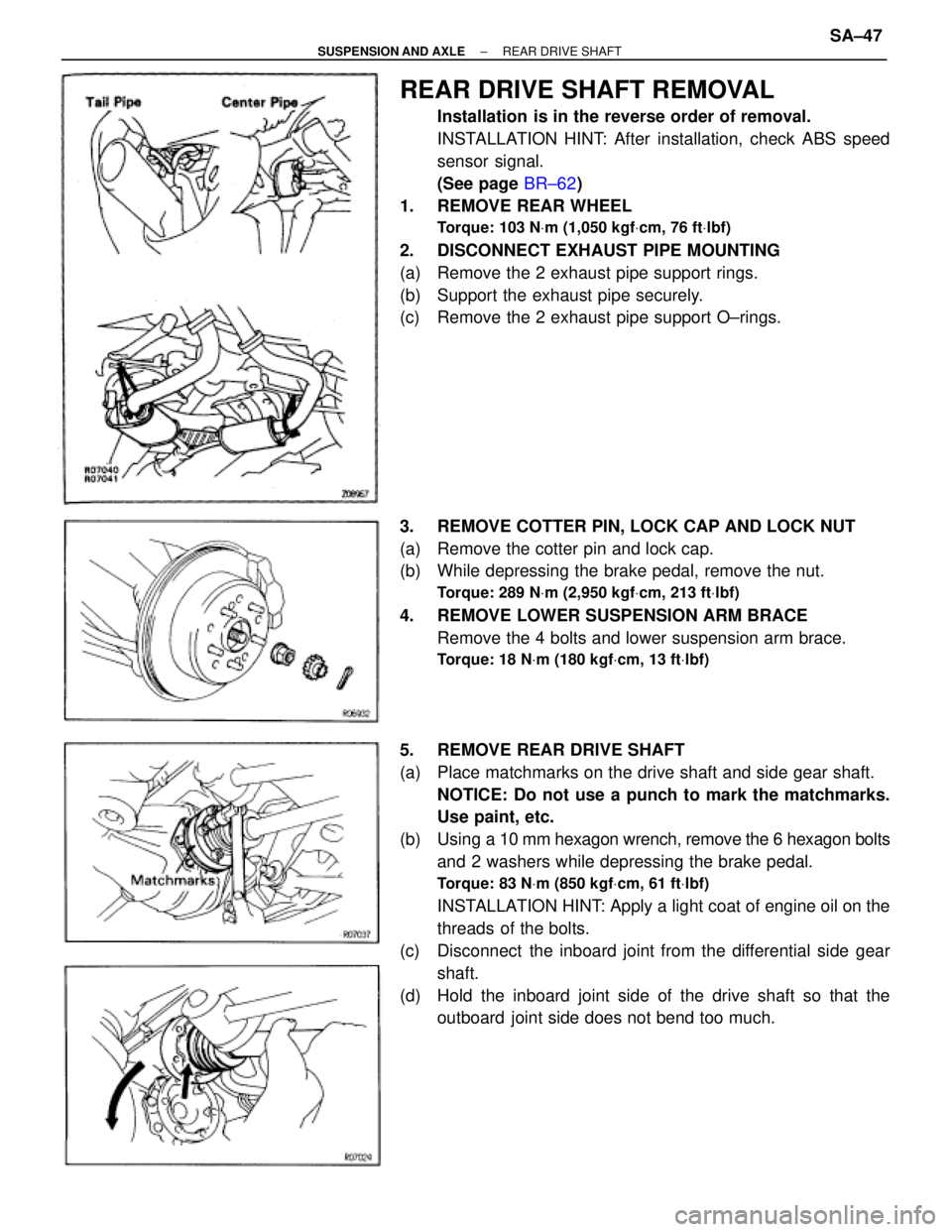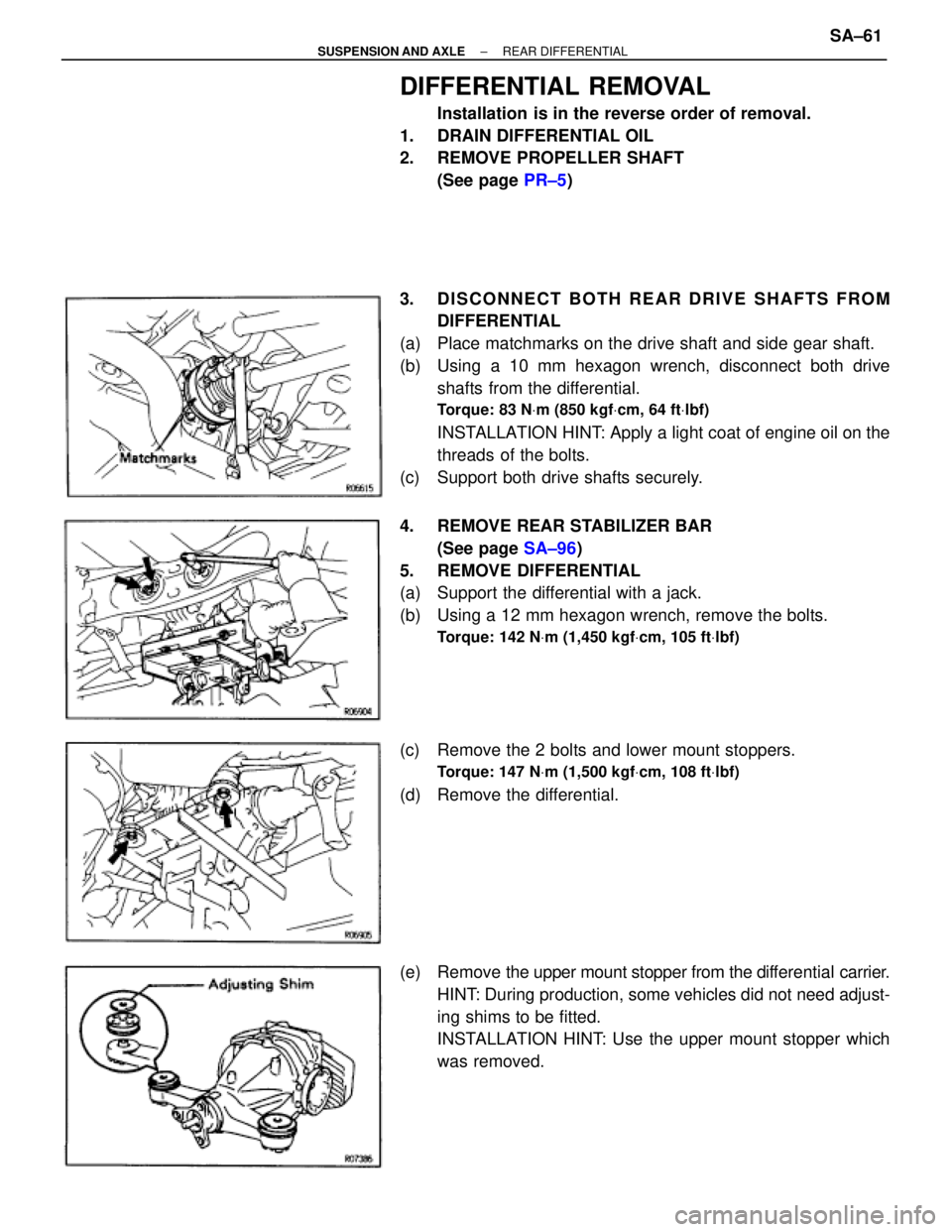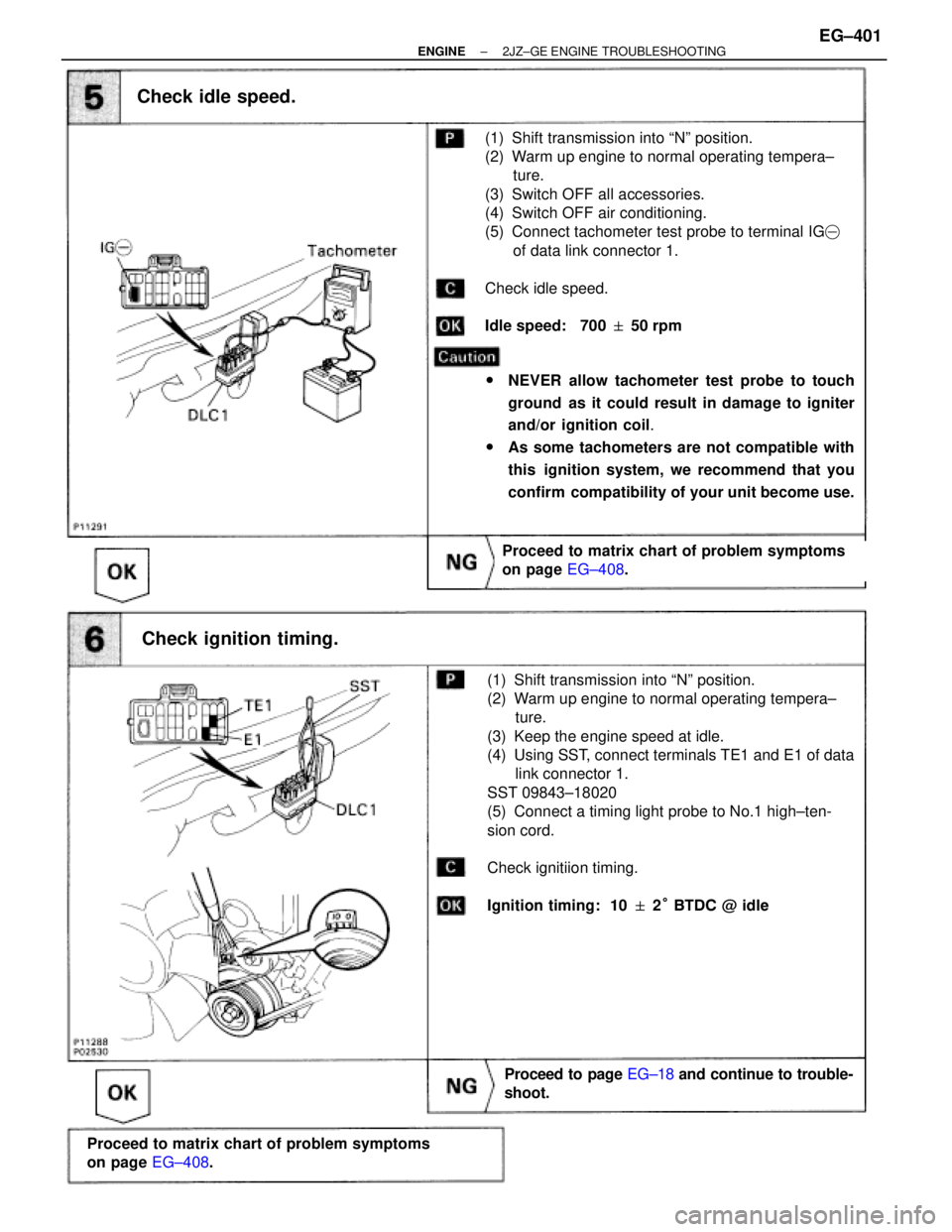Page 1832 of 2543

REAR DRIVE SHAFT REMOVAL
Installation is in the reverse order of removal.
INSTALLATION HINT: After installation, check ABS speed
sensor signal.
(See page BR±62)
1. REMOVE REAR WHEEL
Torque: 103 NVm (1,050 kgfVcm, 76 ftVlbf)
2. DISCONNECT EXHAUST PIPE MOUNTING
(a) Remove the 2 exhaust pipe support rings.
(b) Support the exhaust pipe securely.
(c) Remove the 2 exhaust pipe support O±rings.
3. REMOVE COTTER PIN, LOCK CAP AND LOCK NUT
(a) Remove the cotter pin and lock cap.
(b) While depressing the brake pedal, remove the nut.
Torque: 289 NVm (2,950 kgfVcm, 213 ftVlbf)
4. REMOVE LOWER SUSPENSION ARM BRACE
Remove the 4 bolts and lower suspension arm brace.
Torque: 18 NVm (180 kgfVcm, 13 ftVlbf)
5. REMOVE REAR DRIVE SHAFT
(a) Place matchmarks on the drive shaft and side gear shaft.
NOTICE: Do not use a punch to mark the matchmarks.
Use paint, etc.
(b) Using a 10 mm hexagon wrench, remove the 6 hexagon bolts
and 2 washers while depressing the brake pedal.
Torque: 83 NVm (850 kgfVcm, 61 ftVlbf)
INSTALLATION HINT: Apply a light coat of engine oil on the
threads of the bolts.
(c) Disconnect the inboard joint from the differential side gear
shaft.
(d) Hold the inboard joint side of the drive shaft so that the
outboard joint side does not bend too much.
± SUSPENSION AND AXLEREAR DRIVE SHAFTSA±47
Page 1846 of 2543

DIFFERENTIAL REMOVAL
Installation is in the reverse order of removal.
1. DRAIN DIFFERENTIAL OIL
2. REMOVE PROPELLER SHAFT
(See page PR±5)
3. DISCONNECT BOTH REAR DRIVE SHAFTS FROM
DIFFERENTIAL
(a) Place matchmarks on the drive shaft and side gear shaft.
(b) Using a 10 mm hexagon wrench, disconnect both drive
shafts from the differential.
Torque: 83 NVm (850 kgfVcm, 64 ftVlbf)
INSTALLATION HINT: Apply a light coat of engine oil on the
threads of the bolts.
(c) Support both drive shafts securely.
4. REMOVE REAR STABILIZER BAR
(See page SA±96)
5. REMOVE DIFFERENTIAL
(a) Support the differential with a jack.
(b) Using a 12 mm hexagon wrench, remove the bolts.
Torque: 142 NVm (1,450 kgfVcm, 105 ftVlbf)
(c) Remove the 2 bolts and lower mount stoppers.
Torque: 147 NVm (1,500 kgfVcm, 108 ftVlbf)
(d) Remove the differential.
(e) Remove the upper mount stopper from the differential carrier.
HINT: During production, some vehicles did not need adjust-
ing shims to be fitted.
INSTALLATION HINT: Use the upper mount stopper which
was removed.
± SUSPENSION AND AXLEREAR DIFFERENTIALSA±61
Page 1908 of 2543
BASIC INSPECTION
In many cases, by carrying out the basic engine check shown in the following flow chart, the location causing
the problem can be found quickly and efficiently. Therefore, use of this check is essential in engine trouble-
shooting.
If there is a problem, and a normal code is displayed, proceed to the matrix chart of problem symptoms on page
EG±408. Make sure that every likely cause of the problem is checked.
EG±408.
Is battery positive voltage 11 V or more when engine is stopped?
Is engine cranked?
Does engine start?
Check air filter.
Charge or replace battery.
Proceed to matrix chart of problem symptoms
on page EG±408.
Repair or replace.
Remove air filter.
Visually check that the air filter is not excessive dirty or
oily.
If necessary, clean the air filter with compressed air. First
blow from inside thoroughly, then blow from outside of
the air filter.
EG±400± ENGINE2JZ±GE ENGINE TROUBLESHOOTING
Page 1909 of 2543

Check idle speed.
Check ignition timing.
Check idle speed.
(1) Shift transmission into ªNº position.
(2) Warm up engine to normal operating tempera±
ture.
(3) Switch OFF all accessories.
(4) Switch OFF air conditioning.
(5) Connect tachometer test probe to terminal IG�
of data link connector 1.
Check idle speed.
Idle speed: 700 � 50 rpm
wNEVER allow tachometer test probe to touch
ground as it could result in damage to igniter
and/or ignition coil.
wAs some tachometers are not compatible with
this ignition system, we recommend that you
confirm compatibility of your unit become use.
Proceed to matrix chart of problem symptoms
on page EG±408.
Proceed to page EG±18 and continue to trouble-
shoot.
Proceed to matrix chart of problem symptoms
on page EG±408.
(1) Shift transmission into ªNº position.
(2) Warm up engine to normal operating tempera±
ture.
(3) Keep the engine speed at idle.
(4) Using SST, connect terminals TE1 and E1 of data
link connector 1.
SST 09843±18020
(5) Connect a timing light probe to No.1 high±ten-
sion cord.
Check ignitiion timing.
Ignition timing: 10 � 2° BTDC @ idle
± ENGINE2JZ±GE ENGINE TROUBLESHOOTINGEG±401
Page 1916 of 2543

MATRIX CHART OF PROBLEM SYMPTOMS
When the malfunction code is not confirmed in the diagnostic trouble code check and the problem still can not
be confirmed in the basic inspection, proceed to this matrix chart and troubleshoot according to the numbered
order given below.
EG±438EG±438EG±453EG±460EG±463EG±465EG±470EG±472EG±475EG±457EG±481AC±62ST±3, 12IG±4IG±5IG±7IG±7EG±9AT2±81BE±123IN±35
See page
Suspect area
Symptom
Engine does not crank
No initial combustion
No complete combustion
Engine cranks normally
Cold engine
Hot engine
Incorrect first idle
High engine idle speed
Low engine idle speed
Rough idling
Hunting
Hesitation/Poor acceleration
Muffler explosion (after fire)
Surging
Soon after starting
After accelerator pedal depressed
After accelerator pedal released
During A/C operation
When shifting N to D
Does notstart
Difficult tostart
Poor Idling
Poor
Driveability
Engine Stall
Volume air flow meter circuitECM power source circuitPark/neutral position switch circuitSwitch condition signal circuitEGR systemStarter signal circuitStarter and Starter relayA/C signal circuit (Compressor circuit)VSV circuit for fuel pressure controlFuel pump control circuitIAC valve circuitInjector circuitBack up power source circuitIgnition coilSpark plugIgnition signal circuit (Spark test)CompressionA/T faultyDistributorEngine control module (ECM)Theft deterrent ECU
EG±408± ENGINE2JZ±GE ENGINE TROUBLESHOOTING
Page 1917 of 2543
CIRCUIT INSPECTION
DTC 12 G NE Signal Circuit (No.1)
CIRCUIT DESCRIPTION
The distributor in the Engine Control System contains 3 pick±up coils (G1, G2 and NE).
The G1, G2 signals inform the ECM of the standard crankshaft angle.
The NE signals inform the ECM of the crankshaft angle and the engine speed.
���� ����DTC No.�������������������� ��������������������Diagnostic Trouble Code Detecting Condition�������������� ��������������Trouble Area���� �
��� �
��� ����12
�������������������� �
������������������� �
������������������� ��������������������
No ºNEº or ºG1º and ºG2º signal to ECM for
2 sec. or more after cranking
�������������� �
������������� �
������������� ��������������
� Open or short in NE, G circuit
� Distributor
�Open or short in STA circuit���� ����
12
�������������������� ��������������������Open in ºG�ª circuit�������������� ��������������� Open or short in STA circuit
� ECM
± ENGINE2JZ±GE ENGINE TROUBLESHOOTINGEG±409
Page 1918 of 2543
INSPECTION PROCEDURE
Check resistance of each pickup coils in distributor.
INSPECTION USING OSCILLOSCOPE
Replace Distributor
Repair or replace harness or connector
Check for open and short in harness and connector between engine control
module and distributor (See page IN±30).
Disconnect distributor connector.
Measure resistance between each terminal shown
in the table below.
ªColdº is from Ð 10°C (14°F) to 50°C (122°F)
and ªHotº is from 50°C (122°F) to 100°C
(212°F).
wDuring cranking or idling, check waveforms between
terminals G1, G2, NE and G � of engine control
module
HINT: The correct waveforms are as shown.
G1 pickup coil
G2 pickup coil
NE pickup coil
(NE±G �)
(G1±G �)
(G2±G �)
Resistance
EG±410± ENGINE2JZ±GE ENGINE TROUBLESHOOTING
Page 1919 of 2543
Check air gap.
Remove distributor cap & rotor.
Using SST (G1 and G2 pickups) and a thickness gauge
(NE pickup), measure the air gap between the signal ro-
tor and pickup coil projection.
SST 09240±00020 for G1 and G2 pickups
Air gap: 0.2 Ð 0.5 mm (0.008 Ð 0.020 in.)
Replace distributor housing assembly
Check and replace engine control module.
± ENGINE2JZ±GE ENGINE TROUBLESHOOTINGEG±411